How to watch 4K content
Check out the latest developments when it comes to 4K video
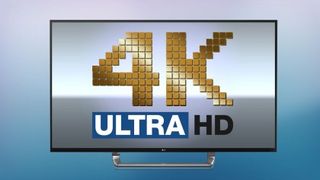
Your guide to 4K
4K. Four Kay. Ultra High Definition. UHD. Forky. Puuuurdy. No matter what you call it, the replacement for HD video resolution is now a standard part of the home entertainment lexicon.
Like the megapixel race of the cameras of yore, and the MHz race of CPUs of even more yore, there has been a push for higher resolution screens. And indeed, with larger TVs such as the LG 65EG960T 4K OLED becoming standard, and projectors moving from 'enthusiast' to 'consumer' levels, there is a definite need for more pixels.
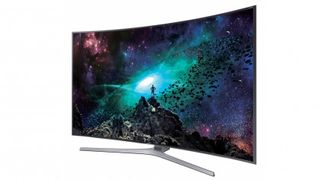
The basics of 4K
So, how many pixels are there in 4K, compared to HD? To start, the term '4K' isn't quite as clear cut as it should be: in the cinema world, 4K has been around for years, and has meant anywhere between 4096 x 1744 and 4096 x 3072 pixels (across about 10 standard aspect ratios and sizes), whereas the consumer tech now referred to as '4K' or 'UHD' is actually 3840 x 2160 pixels.
Why the difference? Well, 3840 x 2160 simply doubles the horizontal and vertical resolutions of the existing HD standard (resulting in 4x more total pixels), making it retain the 16:9 'widescreen' aspect ratio that digital TV is broadcast in (and all our TV sets conform to), so it makes sense to stick with it.
While more is usually regarded as better, does it make sense to increase the number of on-screen pixels? On many screens and from most seating positions, your eyes are unable to tell the difference between regular ol' HD and 4K. Where 4K does shine, however, is on large or those new-fangled HDR screens (which we'll get to shortly).
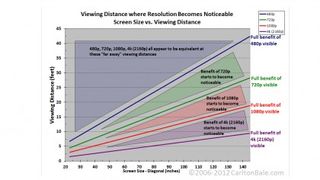
Why should I go 4K?
How large, you ask? Well, in order for you to discern the edges of those 8.2 million or so pixels, you'll have to be sitting within 1.5m of a screen about 60" in size (the larger the screen, the further back you'll be able to notice pixels). On screens smaller than 55", there's almost no point, unless you're sitting within a metre (like at a desk).
For these reasons (and because 55" TVs make up 64% of all TV sales, according to LG), it seems unlikely that 4K TVs smaller than 55" will arrive on the market in the near future – even though 4K computer monitors are selling like pulled pork brioche burgers at hipster bars.
However, even if you don't buy into the arguments put forth for extra pixels, 4K videos – depending on their source – will bring a host of improvements in addition to their increased resolution. First, though, let's discuss those sources, as getting your digital mittens on 4K video is actually a lot trickier than you might expect.
(Image credit: http://s3.carltonbale.com/resolution_chart.html.)
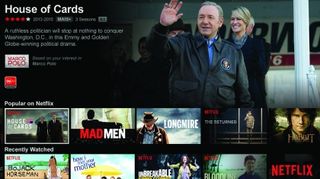
4K sources: Netflix
Perhaps surprisingly, despite there being a multitude of 4K TVs on the market, there is but a handful of external 4K playback sources and only a sliver of 4K content.
Netflix and YouTube are the two biggest 4K streaming services at the moment, and while many 4K TVs out there will support Netflix natively via a wired Ethernet connection, there is only a limited number of 'UHD' (Netflix's preferred term) movies and TV shows available from the service. Further, while there are a lot of people uploading 4K (cat) videos to YouTube, it's still only possible to access them from a computer (conceivably one hooked up to your TV via HDMI).
Additionally, you'll need a hefty internet connection and download quota to be able to really take advantage of streaming 4K. Netflix's 'UHD' stream clocks in at 15.5 megabits per second (Mbps – or 1.9375 megabytes per second aka MBps – note the capital 'B'), recommending an internet connection greater than 25Mbps (3.125 MBps) for UHD,
As such, if you're considering streaming 4K, we'd recommend popping over to speedtest and seeing how your connection rates before committing. Just be sure that you have a generous download limit, too, as a two-hour UHD movie from Netflix sits close to 18 GB in size, and a 13 episode TV series at a staggering 117 GB.
Crucially, if you're looking to stream Netflix to your 4K TV, check that it is indeed certified for it. It not only has to support the new HEVC codec, but Netflix themselves has to certify devices for playback, too (sometimes, your TV may only need a firmware upgrade to get that certification).
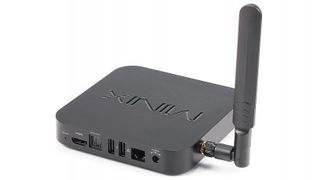
4K Sources: Other devices
If your TV isn't out-of-the-box Netflix UHD compatible, you can consider hooking up a HTPC (home theatre PC) to your TV, and setting up a proper geek's lounge room. Just make sure that your video card supports HDMI 2.0, so that you won't be limited to 30fps video.
The benefit of a HTPC is that you can also watch 4K YouTube content, as well as chuck in a TV tuner or two and set it as a PVR for free-to-air TV – note that it takes a bit of creativity (and hardware) to route Foxtel through your HTPC, but it is possible.
Playback of 4K content via USB is now a standard feature for 4K TVs, but wasn't the case in 2013 when the first models came out. Some of the cheaper 4K TVs may also have problems playing back downloaded 4K content over USB, so make sure to check before you commit.
Another option for viewing 4K content on your TV is to purchase one of the many Android-based, 4K-compatible mini PCs now on the market (such as the Minix Neo X8-H Plus, which is just over $200 on eBay). While these can play back 4K movies, they only currently support Netflix at 1080p. Also, I haven't had the luxury of trying one out, so can't speak of their quality. Minix have been around for a few years, though, and seem to have a strong following, so they can't all be bad.
Unfortunately, console owners are out of luck when it comes to 4K: the Xbox One doesn't support it at all, and the PlayStation 4 only supports it at 30fps (thanks to its HDMI 1.4 port), and even then, the PS4 Netflix App only supports up to HD resolution, and the PS4 doesn't allow you to bring your own videos (instead asking you to pay for Sony's 'Video Unlimited' service).
However, rumours are abound that both the Xbox One and the PlayStation 4 will receive hardware updates this year that will upgrade them to HDMI 2.0 and enable 4K playback at 60fps from streaming sources like Netflix, and maybe even locally stored content, too. Who knows? – they may even support the soon-to-be-released 4K Ultra HD Blu-ray discs.

4K Blu-ray - more than just pixels
4K Blu-ray discs should be coming out before the end of 2015 (there were some prototype 4K Blu-ray players seen at CES this year, so they are getting close). The discs will be encoded using the newer HEVC/H.265 codec, which is a much more efficient method of compression (in fact, HEVC stands for High Efficiency Video Coding).
In tandem with this improved compression will be an increase in the capacity of Blu-ray discs – up from 25 GB or 50 GB to 66 GB and even 100 GB. Most notably – and this is where the superiority of physical media over streaming plays out – all that extra space will allow for more than just extra pixels: each pixel will also be filled with more data! So, movies coming on the new discs will also support a wider colour gamut, better contrast, and faster frame rates.
Movies stored on 4K Blu-ray will use what is called the BT.2020 (aka Rec. 2020 or ITU-R Recommendation BT.2020) standard for video, which defines a video format's resolution (either '4K' 3840 x 2160 or '8K' 7680 x 4320 – although it will be a while before we see anything 8K), its possible frame rates (from 24 up to 120 – useful for 3D – with many stops in-between), and the bit-depth of the data (either 10 or 12 bits per sample – up from the 8 bits seen today, which translates to a jump from 16.78 million colours to 1,073,741,824 colours for 10 bit and a whopping, staggering, jaw-dropping 68,719,476,736 colours for 12 bit).
Now, the BT.2020 recommendation is built for the future, so 4K Blu-ray will sit at the bottom of the specs – that is 4K resolution, 24 fps (for most content, but up to 60 fps for some), and 10 bits per sample – but this is still a fundamental shift in picture quality. So much so that current TVs can't even display all those new colours and shades, and will likely have to sample-down when faced with them. That is, unless you have an 'HDR' TV.
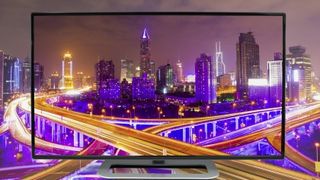
HDR Video
'HDR video' (or High Dynamic Range) has been a buzzword floating around the industry for a bit, but really made itself known at this year's CES, where there were sample TVs on display from LG, Sony, Samsung, Philips, Panasonic and others, and Dolby announced their standard for HDR, known as 'Dolby Vision'.
The 'dynamic range' that HDR refers to is basically the difference between the darkest object and the brightest object that can exist in a frame together – in this sense it's almost another term for 'contrast ratio.'
However, it also encompasses the possible shades of colours, too. And, as contrast ratio plays a bigger part in the perceived quality of an image than resolution, you can see why we're a little excited about HDR screens and HDR movies (whether via a lightly compressed 4K Blu-ray or heavily compressed Netflix stream) coming to home theatres.
Basically, with an HDR movie playing on an HDR screen, expect significantly more realistic pictures – not only will you have deeper blacks alongside brighter whites, you'll also have many, many more shades and colours in between.
It's actually quite a technical achievement to have so many colours and shades displayed on a panel, and has only become possible recently thanks to 'quantum dot' coloured backlighting technology for LCDs as well as the maturation of OLED panels.

The future of 4K
In regards to 4K Blu-ray, like every other launch of a new medium, expect both the players and the releases to be very thin on the ground at launch. However, unlike when Blu-Ray launched back in 2006, there isn't a competing physical format, like HD DVD or Betamax (just video on-demand steaming services) – all studios are on-board to support it as the medium of choice for 4K content, which is a boon for consumers.
The biggest challenge for 4K Blu-ray, however, is the very simple fact that sales of physical media are down. And as shiny and technically impressive as the format is, Joe Consumer won't care a hoot about it if he can get the 'same thing' streaming over Netflix. So, watch this space for updates.
